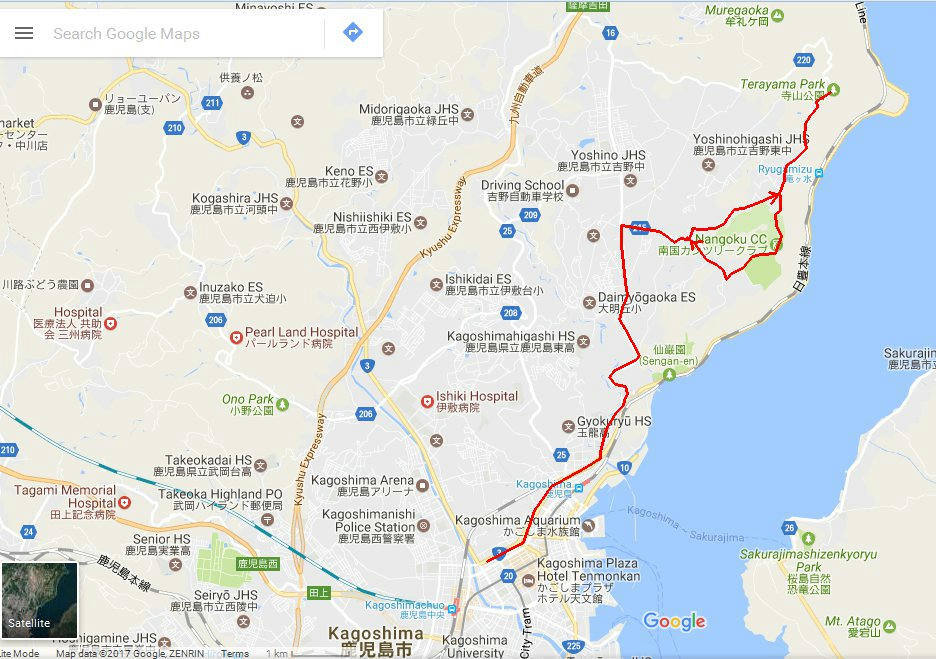
(Map from google maps)
It's been well over a year since I took one of my long walks around Kagoshima. The hike to the top of Kaimondake mountain on New Year's Day, 2016, doesn't count because that was specifically intended to see if I could get to the top. The long hikes are usually more about distance, and seeing what I can find along the way. Jan. 3rd was the first real chance I had to do a long walk, since I didn't have to work the next day, and I had no obligations on the 3rd. The problem was that I've visited most of the places I've wanted to go in the area within walking distance, so I changed the goal to "how far can I walk in 1 day". With this new goal, the target became clearer - whatever was north of the city, up in the direction of Aira and Hayato (which I've been to by bus before). One of my last walks had been along the street in front of the apartment, which runs north past the Reimeikan history museum, up into the hills and into Yoshino city. This time, I'd follow the same route to Yoshino, and when I got to road 215, I'd head east and try to find signs for a shrine that showed up on google maps, but was kind of hidden in the hills and not near any big streets. I expected that this would push my limits a little too much and I'd have to give up, but it was a visible target.
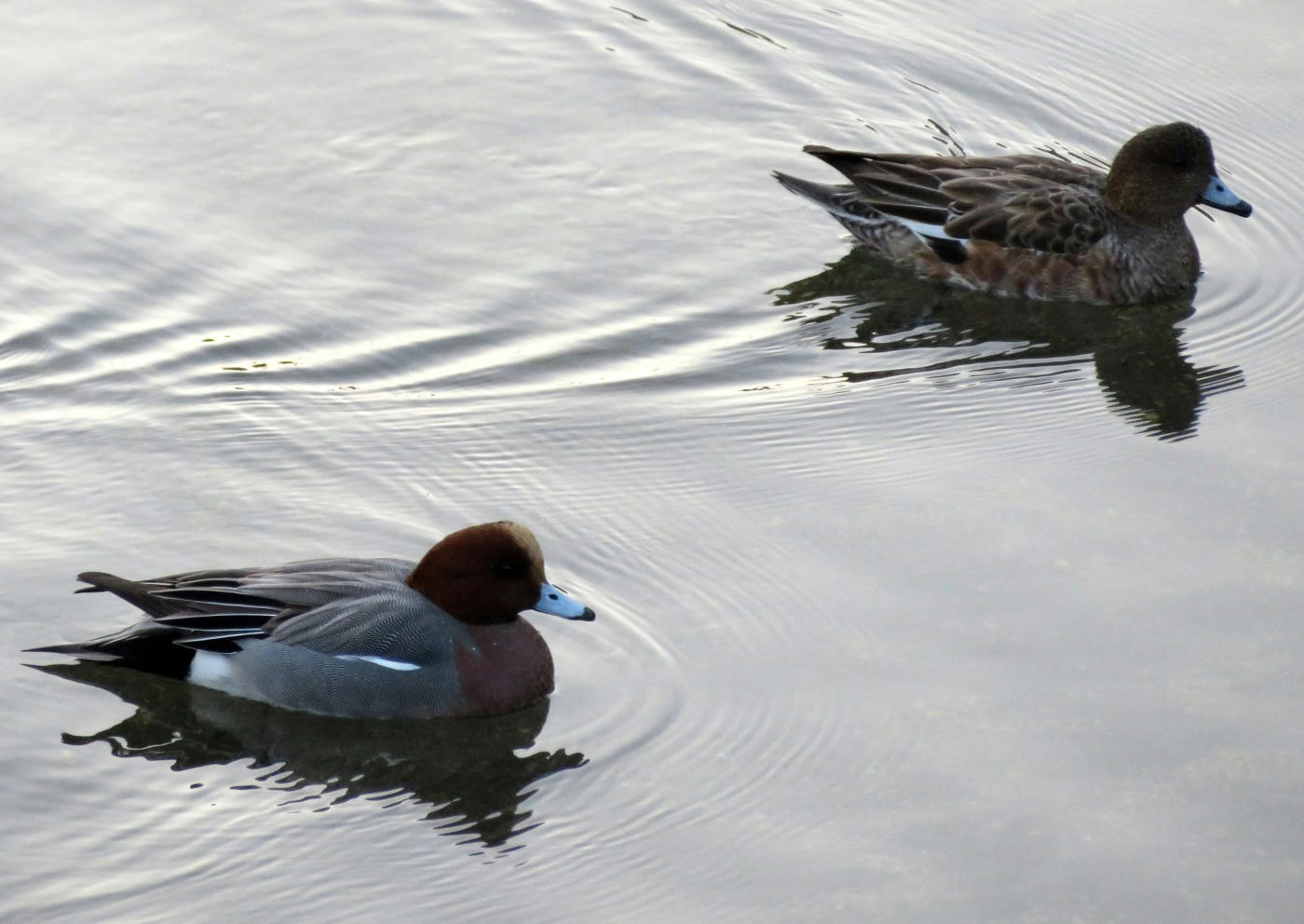
I set my alarm for 6:30 AM. When it went off, I'd only had maybe 5 hours sleep. I was hoping the weather had turned bad so I'd have an excuse to go back into bed. I checked the computer, took a shower, then went outside at 7:10 AM. The sun was now up far enough that I could tell that this was going to be a beautiful day. Sigh. I took my little camera, and my MP3 player with 3 new CDs' worth of music I'd gotten for Christmas (Equinoxe, The Greatest Hits of the Red Hot Chili Peppers and Trans-Siberian Orchestra's Beethoven) and started walking. I got to Reimeikan after 20 minutes, and kept going past the bridge over the train tracks (the train runs from the main Chuo station to the original Kagoshima station, then up past Senganen to Aira and Hayato). There was a fair amount of car traffic already, although most of the shops and grocery stores were either closed for the holiday week, or just not open that early. About 10 minutes later, I got to Inari river. There was one duck that had a head shape a little different from the ones on the Kotsuki river closer to the apartment, so I stopped to take a couple photos. These two are smaller than the Kotsuki ducks, too.
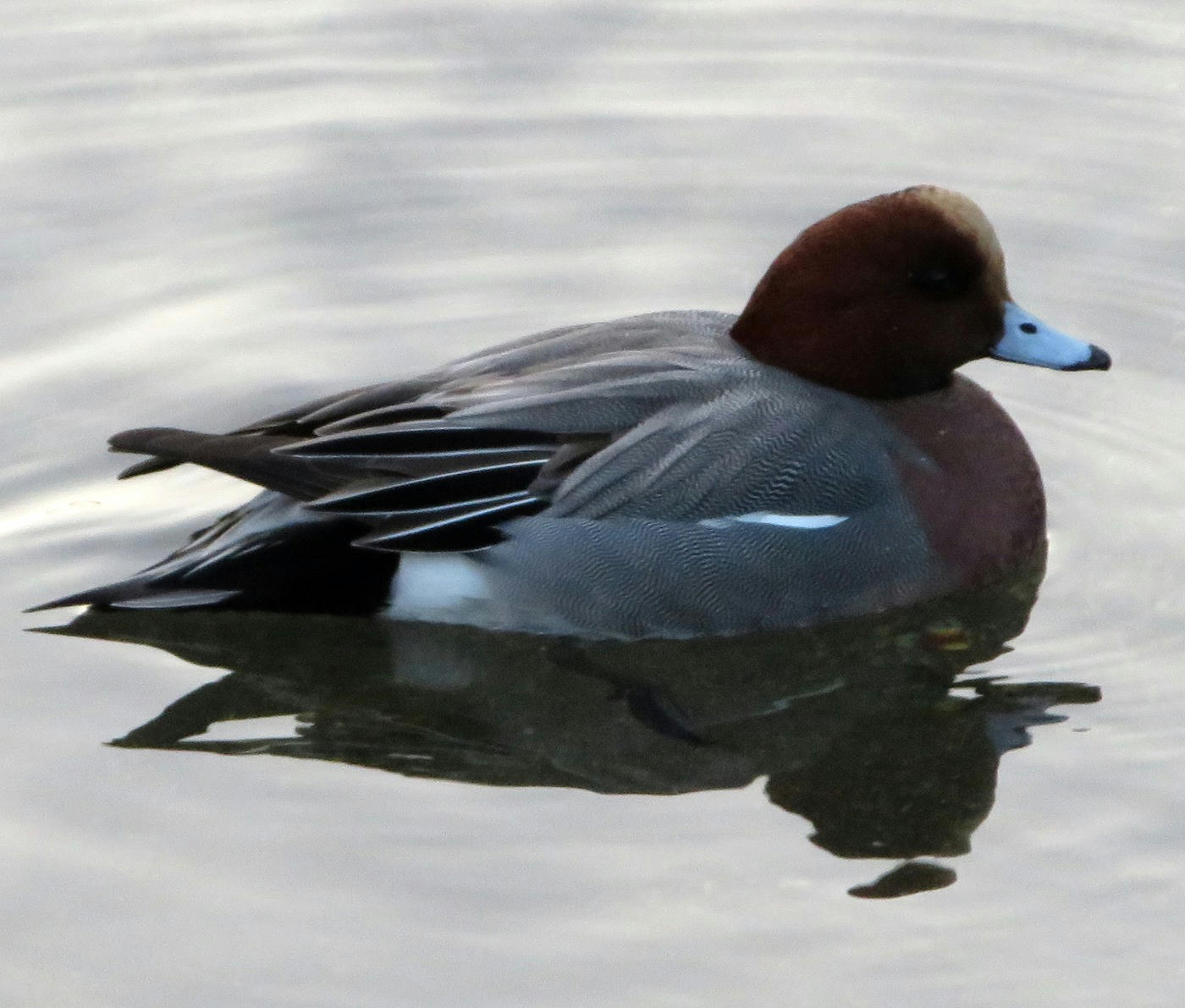
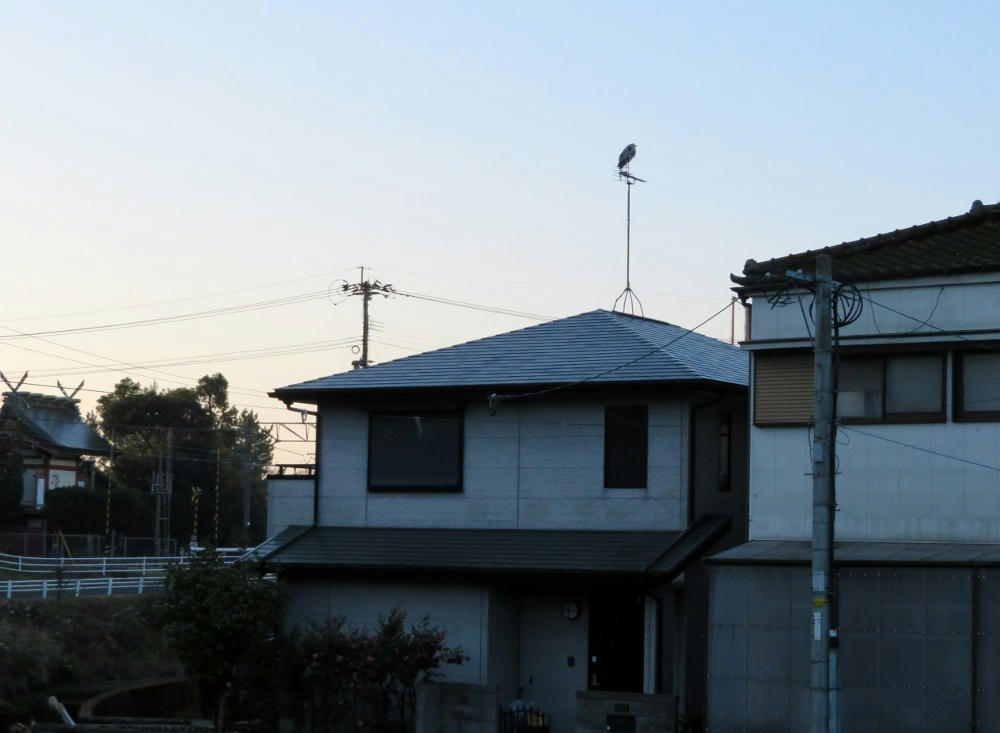
I looked for other ducks, then eventually noticed the heron on the TV antenna nearby.
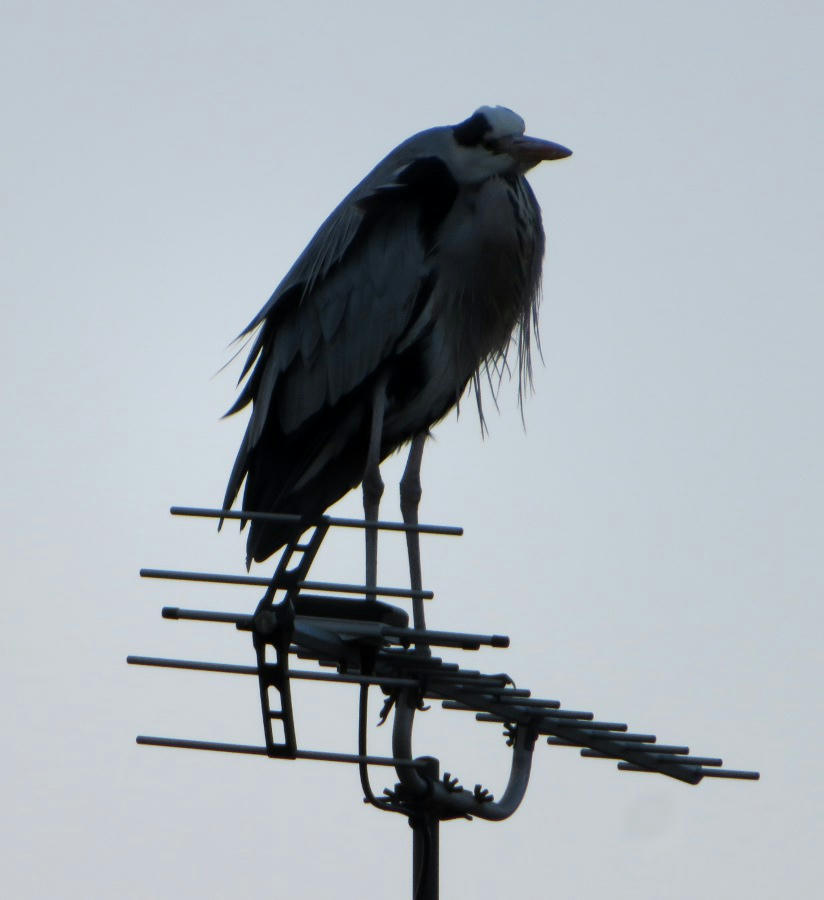
I bet he gets great reception there.
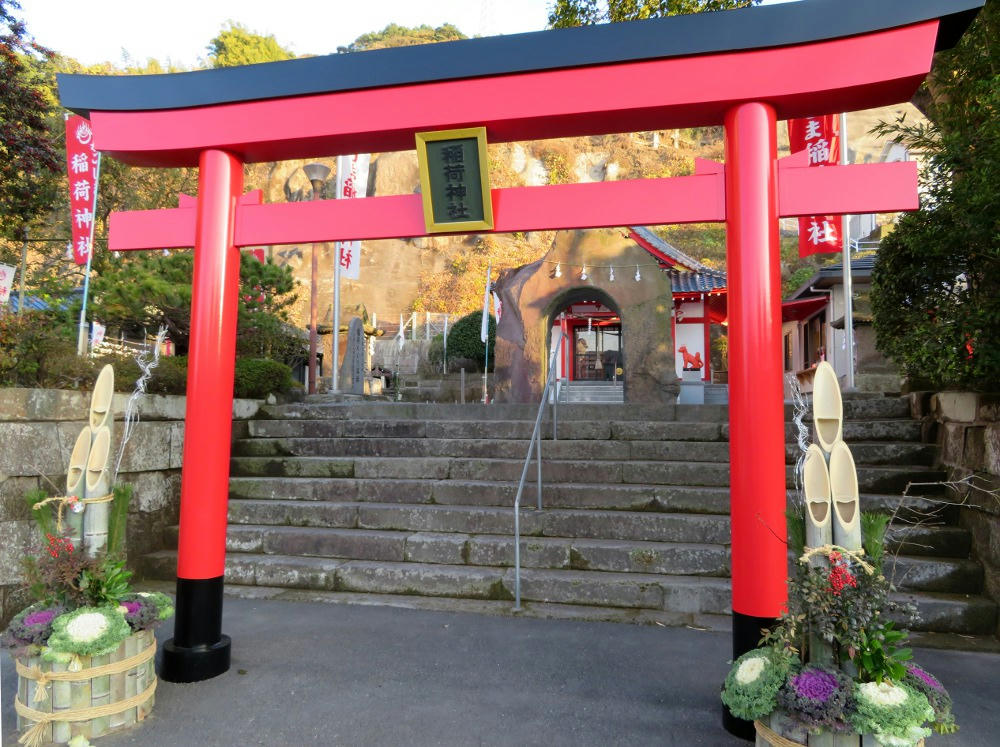
Then, I worked my way over to the hill between me and Senganen, and headed more westward to get to the part of the streets where I could avoid going through the car tunnels to get to the other side of the hill (the air in the tunnel is almost unbreathable because of the exhaust fumes). This brought me within a couple blocks of Inari shrine. It's a nice little building, and I was wondering if anyone was there this early to do hatsumode (the first visit to a shrine for the new year). Turns out the buildings and torii have received new paint. There were only a couple people there, so I took 2-3 photos and kept walking.
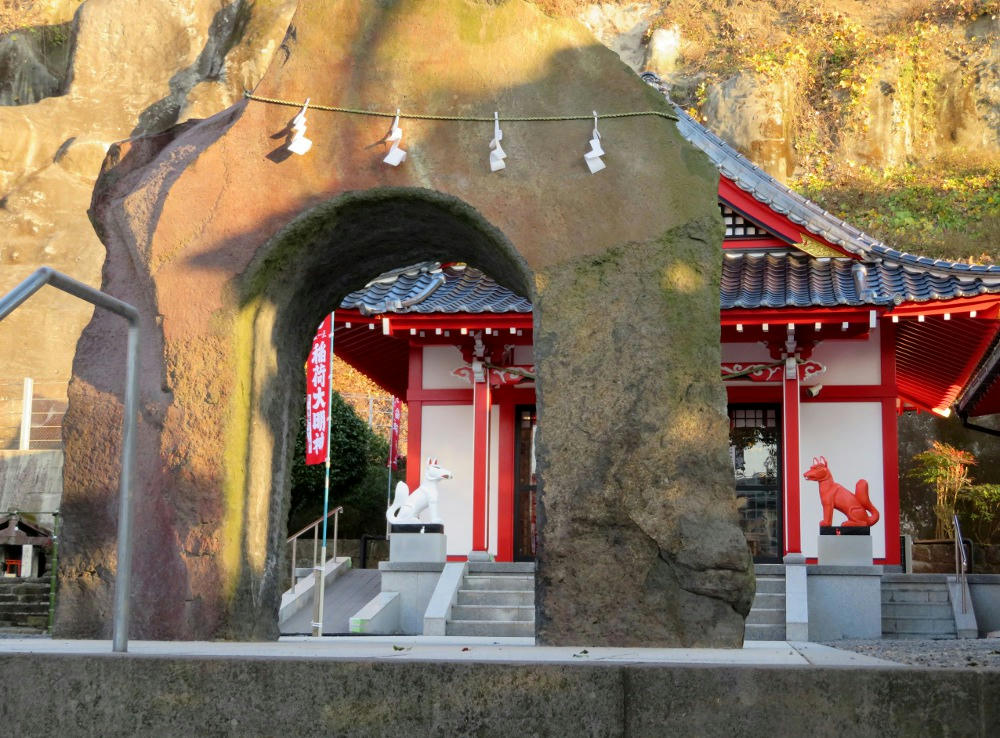
(The white fox statue to the left of the shrine entrance doesn't show up well in the photo.)
From here, I returned to the main street, took a side street when I got to the tunnel entrance, and climbed another side street that brought me back to the main street, only 30-40 feet higher up the hill, after the main street completes a 360-degree loop in the tunnel and re-emerges at the top. The main street then meanders up a series of other hills in a constant incline until reaching Yoshino. This was as far as I'd gotten the last time, and it took 2 hours to reach Yoshino. I was still feeling good, but a bit hungry. I found a 7-11 and bought a salad, an egg-and-ham sandwich (cut into 3 halves of a sandwich) and two 500-ml bottles of water. I found a restaurant (still closed) that had a bench overlooking a cliff drop down to the main residential part of Yoshino, and had the salad there. To this point, the road had hugged the side of the hills, and most of the buildings along the way were little strip malls, and abandoned ramen shops. Yoshino city proper lies farther down in the valley below. The Inari river also runs up a gorge below the road, and there are a couple water purification plants, and hydro-power buildings there, too. Nothing worth taking photos of, though.
At the turn off down into Yoshino, I encountered road 215, so I turned right and continued east down hill, as this road also meandered around a lot. I kept walking, looking for markers for my target temple, but all I saw were street signs for Yoshino Park, Terayama Furusato Park and Terayama Park, 2-4 miles away. I didn't really want to go that far, but I still couldn't see anything showing where the shrine was. After a while, I hit a t-intersection, and I turned northeast because that's roughly where I expected the shrine to be. Eventually, I hit a break in the trees, and I found myself standing high above Kinko Bay, looking at the Sakurajima volcano.
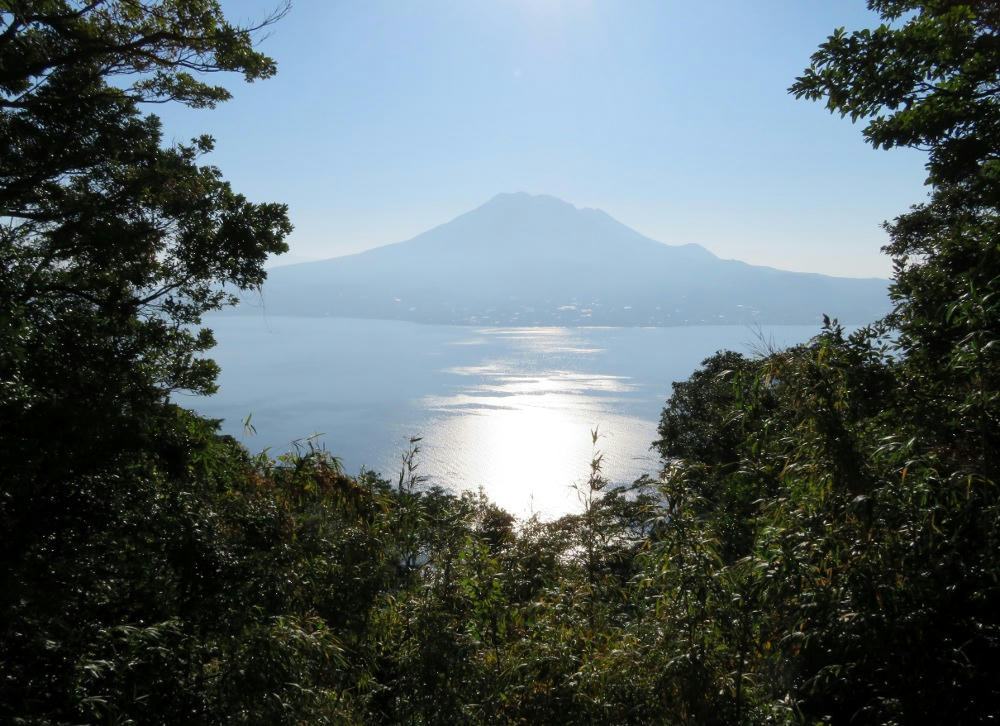
The train running from Senganen up to Aira goes along the coast line at just above sea level. But, there's no way to get down from here to reach the nearest station at water level. I would have been happy to go down a stairway, and take the train back home, but there wasn't one. The thing is, I'd gone too far east by at least a couple miles and overshot the temple. Because I didn't have a map, or a GPS, there was no point in going back to keep trying to find the shrine. Instead, I figured I'd go look at Yoshino park, which was the closest of the far away places on the street signs.
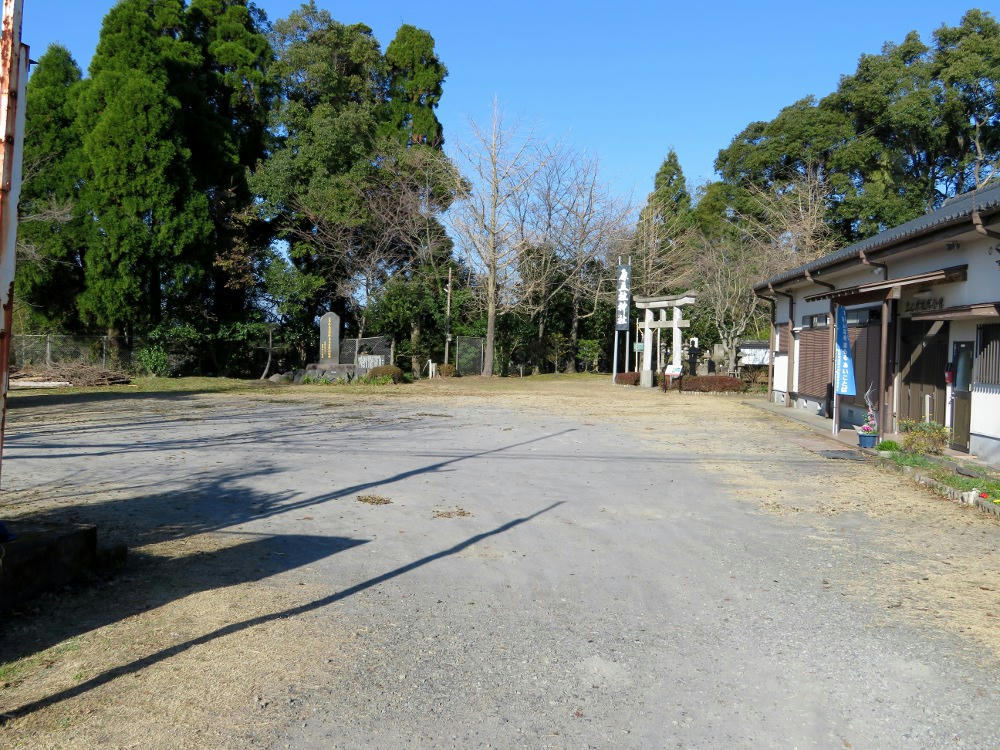
A little farther on, I reached an area identified as Uenohara (upper field), which had another shrine, some monuments, and a community center (closed). It also had a marker for "Geopark #2".
"Haragosha Shrine
A new shrine with the same name helps residents remember their hometown
There are two Haragosha shrines in Sakurajima-Kinkowan geopark. One of them is here. The other one is in Sakurajima, which is famous for "Kurokami Buried Shrine Gate". Why are there two shrines with the same name? When the Sakurajima's Annei eruption of Sakurajima happened (1779-82), large amounts of pumice and lava invaded the village, forcing the residents to flee. Here in the Uenohara district is the village which was founded by the people who escaped from the Kurokami district. They welcomed the god from the original shrine of their hometown of Kurokami at another "Haragosha Shrine". After you pray, please get close to Sakurajima. The form floating dignifiedly in the sea is breathtaking. People who moved from Sakurajima because of the huge eruption surely reminisced about their hometown upon seeing this sight."
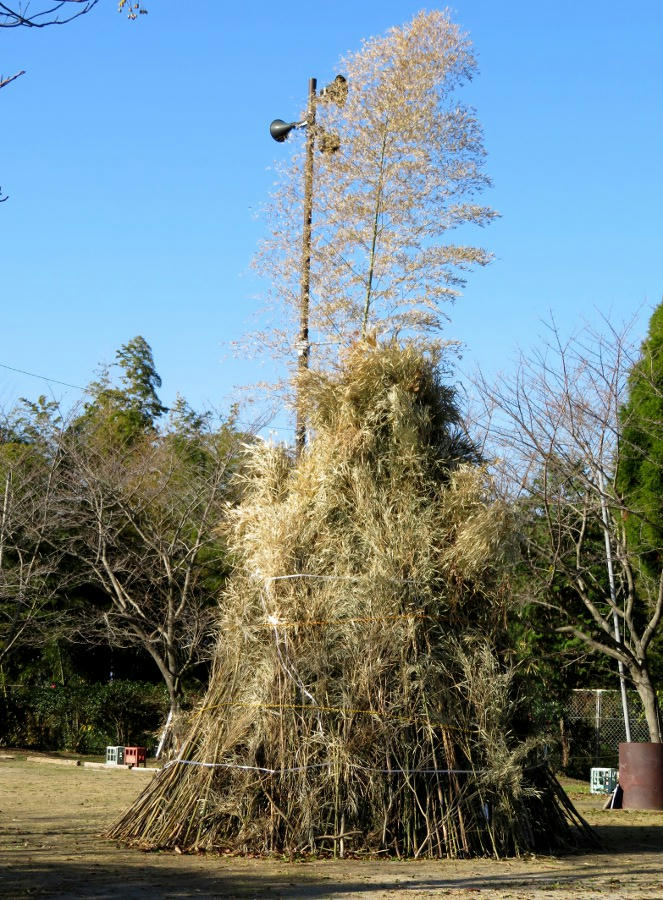
They had a big stack of branches in the middle of the parking lot. I assume that it's going to be used for a bonfire at some point, maybe to burn up old protective amulets from last year that people turned in when they bought new amulets for the new year. I didn't see a sign talking about the branches, though, so I really don't know what they're there for.
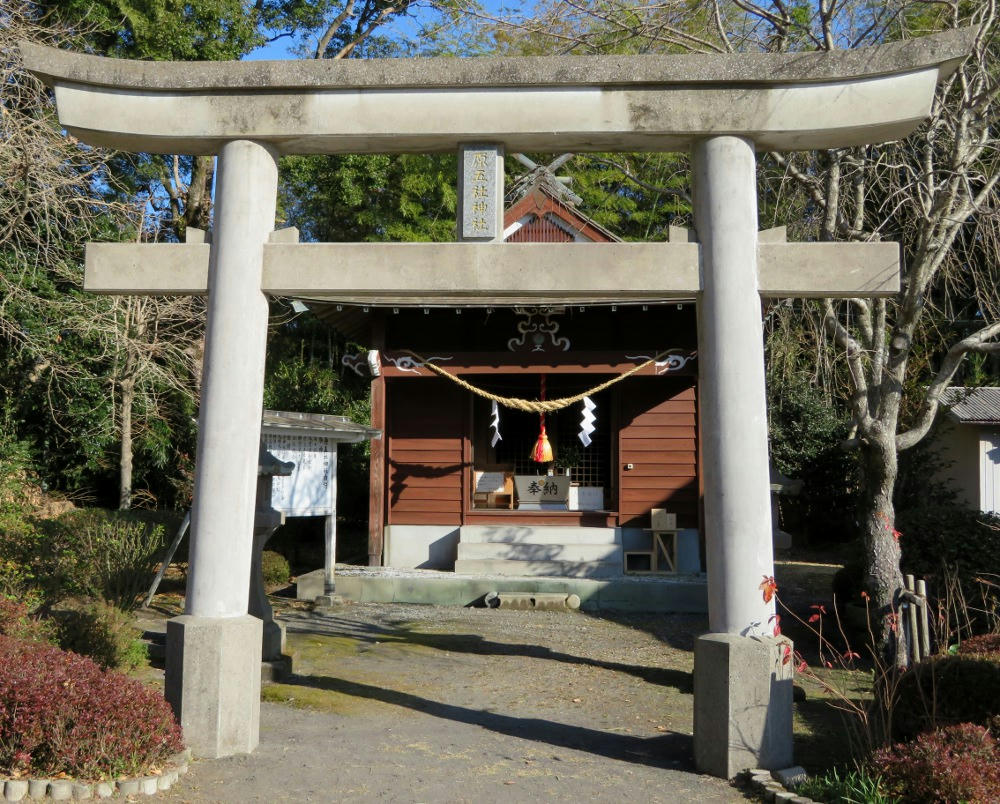
(The replacement shrine.)
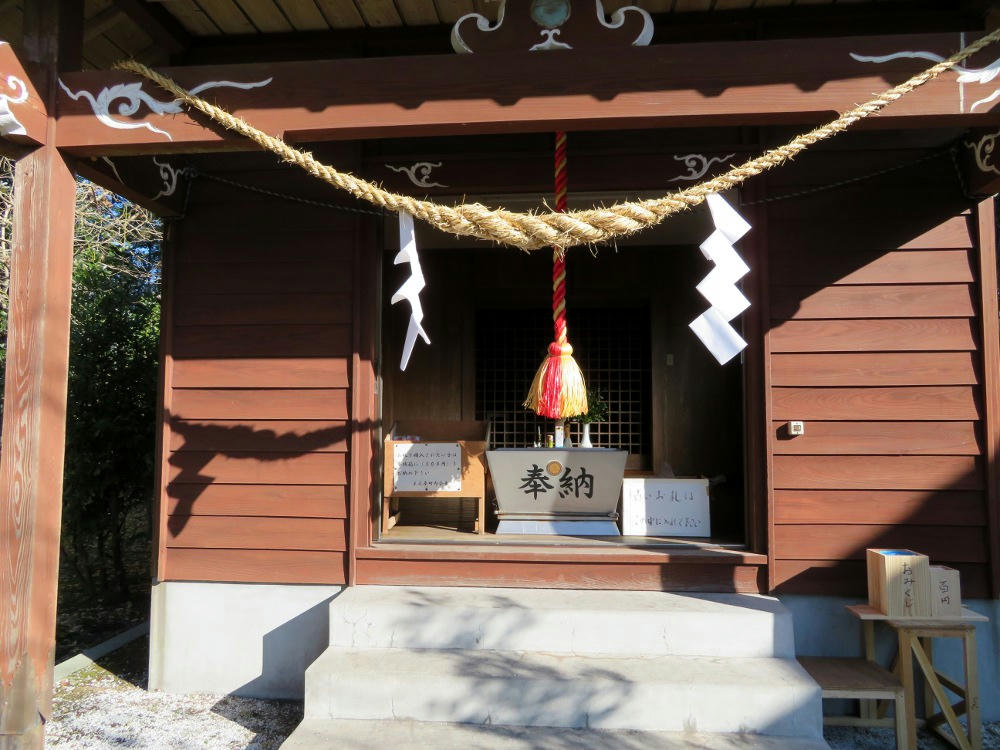
The gray box in the middle is where you toss in a coin with a hole in it (typically a 5 yen coin), then you shake the rope to ring the bell to get the god's attention before praying for good luck for the new year. The box on the left contains protective amulets for sale (on the honor system). The box on the right is where you return used amulets.
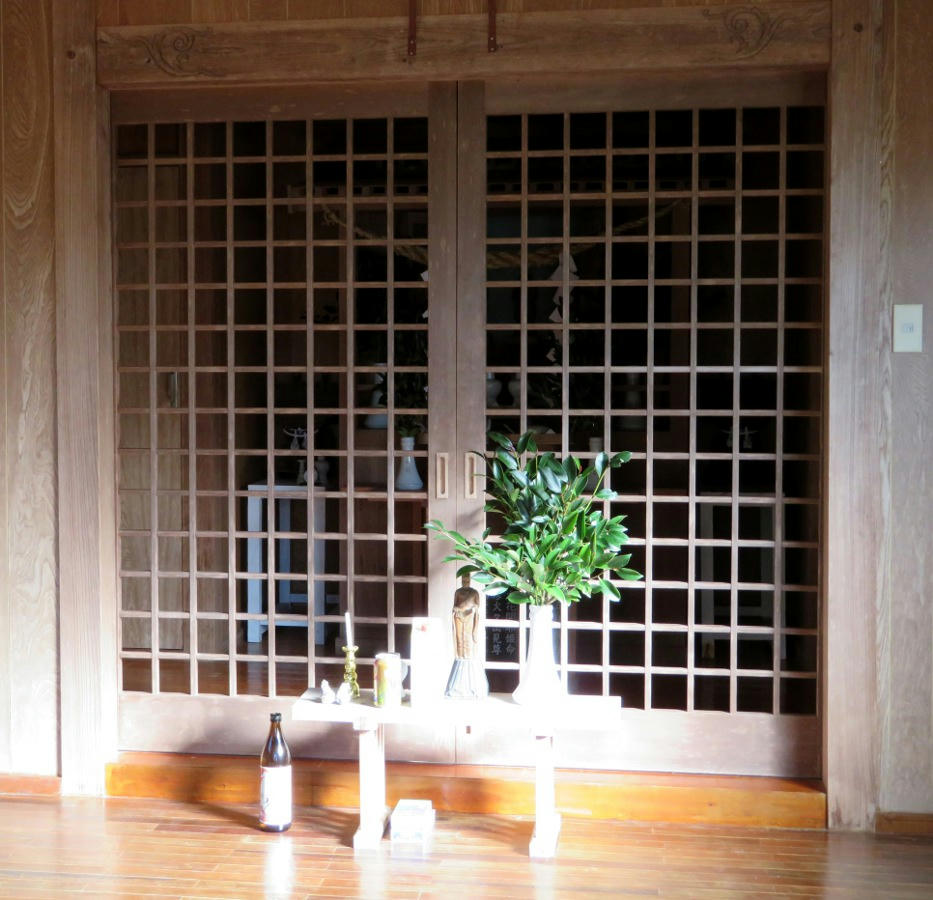
The inside of the shrine has some flowers, figures, candles, and a bottle of sake. The inner shrine area has the altar for the local god.
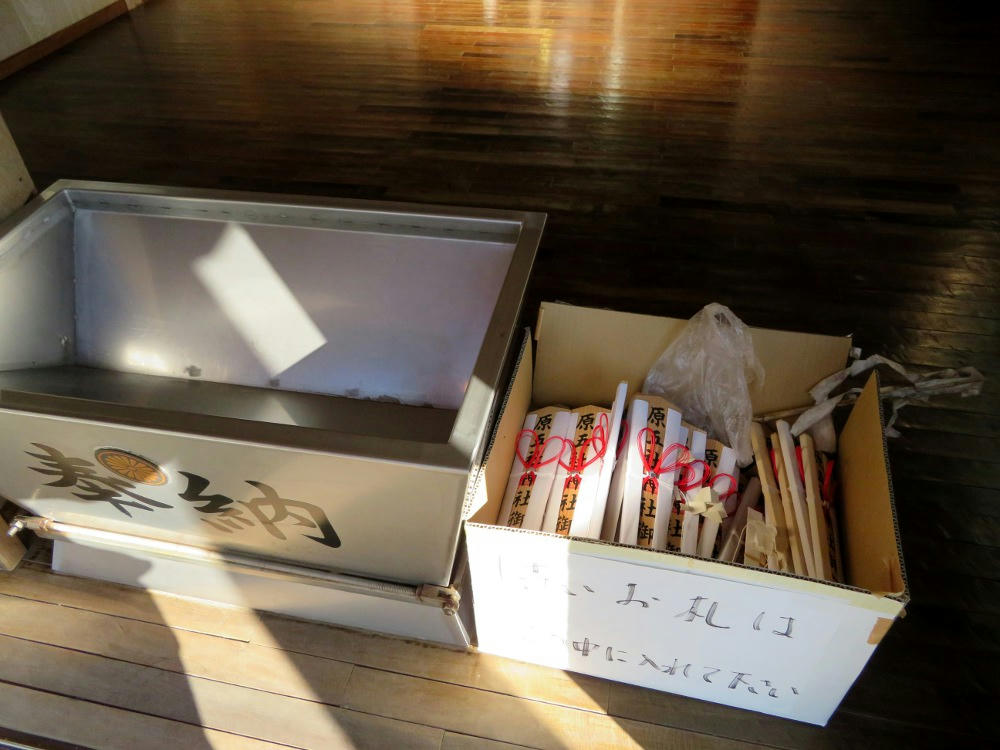
(Close-up of the used protective amulets.)
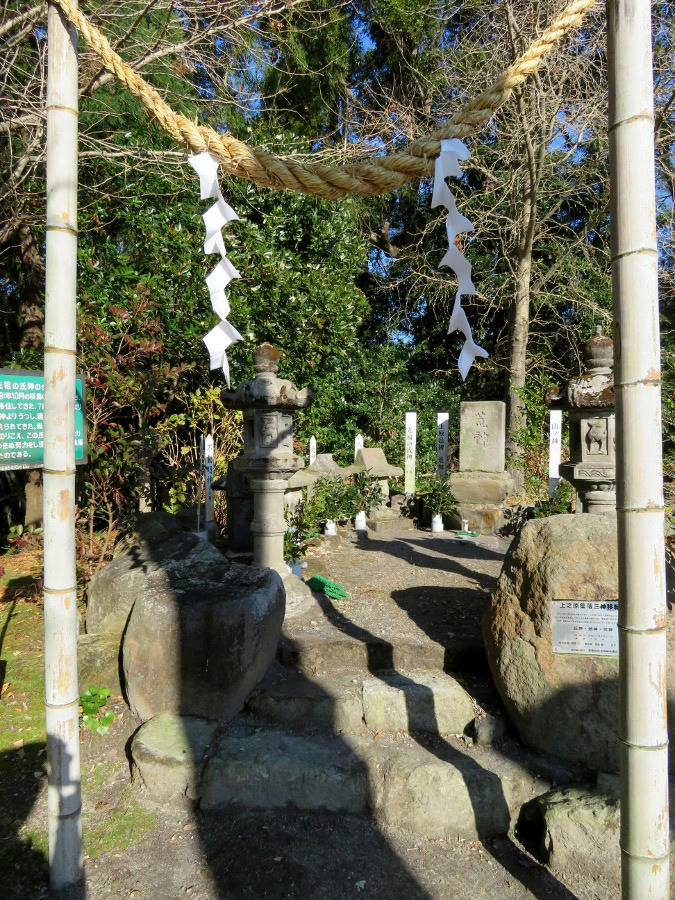
(More monuments)
"Kannohaiyu Monument - Koujin
The Kannohaiyu is in the grove of trees in the village of Kannohai. The monument has the word "Koujin" carved upon it. The belief in "Koujin" the God of the Kitchen, covers a variety of things. However, it can be separated broadly into three different types of beliefs.
1) The belief in the god of the oven of the household and the three sacred treasures of Buddhism, deified in the fireplace within the house.
2) The belief in the "earth gods of the kitchen"; the god of the house, family and village, worshiped outside the house.
3) The belief in a god which was a protector of livestock such as cows and horses.
It is thought that beliefs about the Kitchen God in village of Kannohai fell under the second category. Also, because it was worshiped in Kannohai, there was also "Ubusana" Koujin, and it is thought that he was considered both god of agricultural activities, and protector of the people in their daily lives. At the Koujin Festival, it was required that even those who had married outside the village or had left for work reason return to participate in the ceremonies. We can say that the belief in Koujin, god of the Kitchen, was a central part of the village's spiritual structure.
At the Kannohai monument the following things are recorded: Kannohaiyu are the people who came here to be sheltered from the great eruption of the volcano Sakurajima in 1779 (the 8th year of the reign of the Emperor Ansei). It is said that seven families were displaced at that time. After the initial shift, the population flourished, but due to a lack of farm land the lives of the people became harsh and troubled in the extreme. Then in 1841 (the 12th year of the reign of the Emperor Tempou), representatives of the citizens of the village made repeated petitions to the city government office, which resulted in the allocation of approximately 15 hectares of land from Yoshinomaki area's Karauma to the villagers.
The people were very pleased with this and devoted themselves to the cultivation of the land, resulting in rich production 7 years later, along with a relaxed lifestyle. In September 1848 (the initial year of Emperor Kaei), the electorate of the village had a discussion and decided that the story of the village should be carved into stone so that their descendants would never forget their heritage.
In 1854 (Kaei 7) on September 29, the monument was erected. Also recorded are the names of the feudal domain's officials, the Yoshino village officials and the representatives of the village of Kannohai."
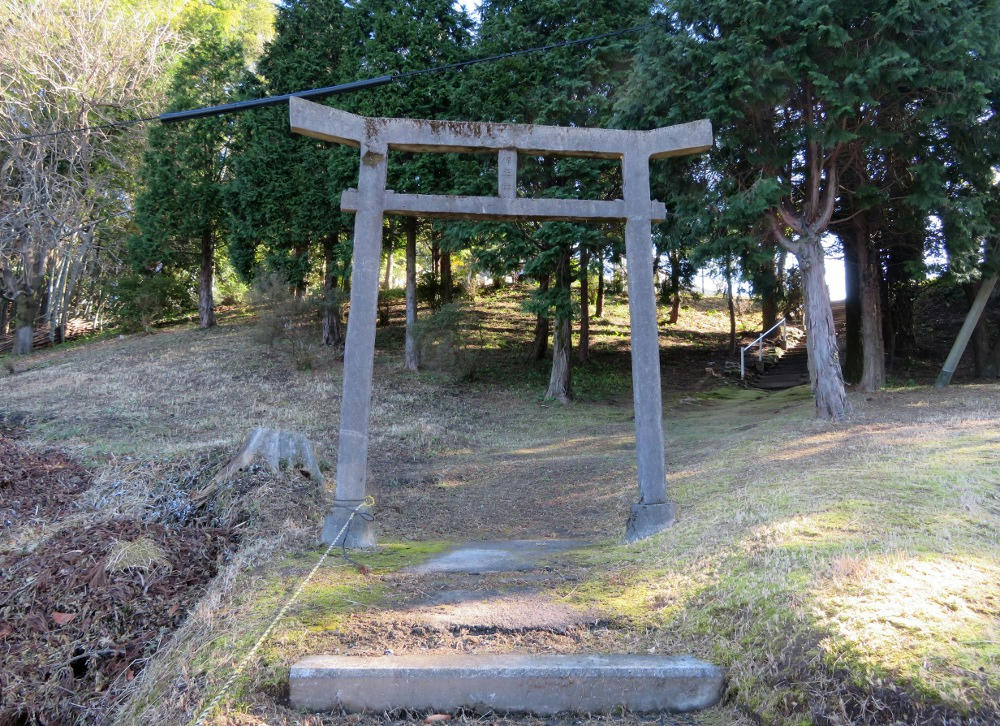
(The torii at the entrance at the backside of the shrine park.)
I assume that the torii was originally for the main entrance to the shrine from the village side. It's not as important now that the main road runs along the bay side of the shrine, and you can just drive up and park your car in the lot right in front of the shrine. Still, the torii here is still picturesque.
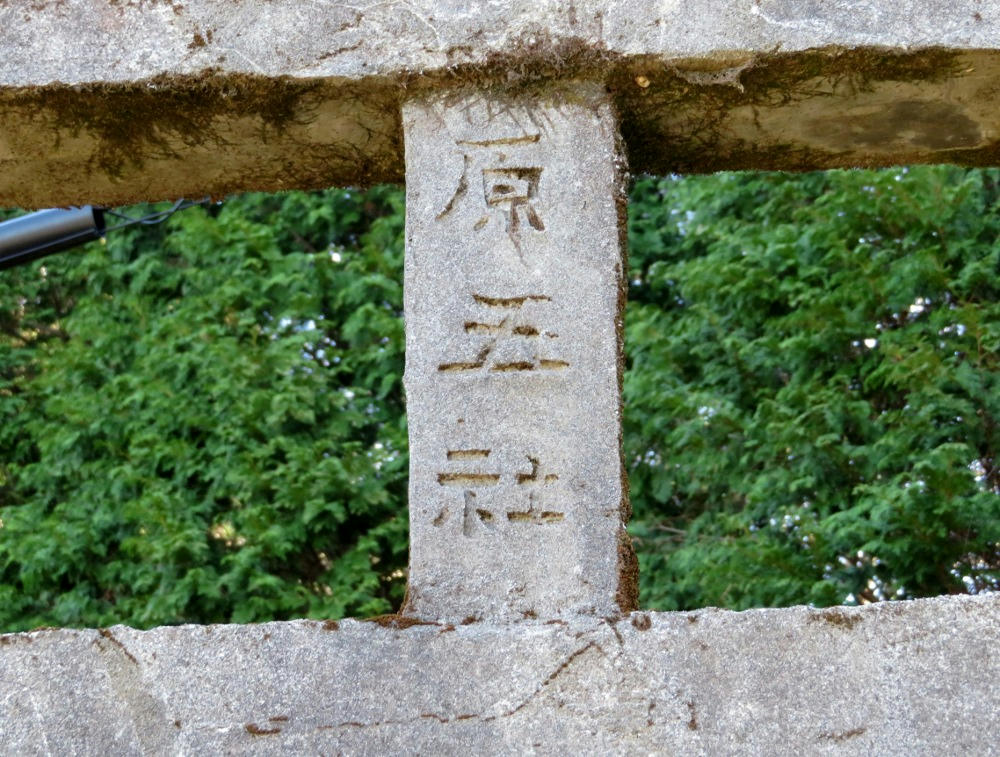
The carving at the top of the torii reads "hara" (field) + "go" (five) + "sha" (obs., probably shrine) = Haragosha.
After spending a few minutes here, I got back on the main road and kept going north. I was getting hungry, and a little frustrated at not finding more stores to buy food from, so I ate one of the sandwich halves, and kept the other two for later, in case there weren't any other places to get food from along the way. At a split in the road, I had to choose between going to Yoshino park and Terayama park. Although Yoshino was closer, Terayama had a historical marker for an old charcoal kiln. I turned left, in the hopes that the historical marker implied the presence of a tea house or something.
Still more walking, and finally I got to the entrance of the Terayama Fureai Park, which turned out to be nothing more than a sporting field, with a couple tennis courts, a big baseball diamond, and a short hiking trail. There were many cars in the parking lot, and lots of kids playing baseball against each other. And one vending machine selling soda and can coffee next to the public toilets. No food, and I was unsuccessful at begging rice balls from people. At least there was a toilet, though.
At this point, I'd been walking 3.5 hours. I threw away the one empty water bottle in the trash bin and bought a third bottle from the vending machine, just in case, and hiked back to the exit of the parking lot. There was a map in the park showing the location of the kiln, about a quarter mile farther up the hill, and I figured I might be pushing my luck trying to get to it. But, I kept going anyway. The Terayama kiln grounds has 2 walking trails, one about 1 kilometer long, and the other maybe 3 times that length. I just wanted to get to the kiln, so I ignored the longer hiking loops. However, there were two other features on my path that I didn't have to go out of the way to visit.
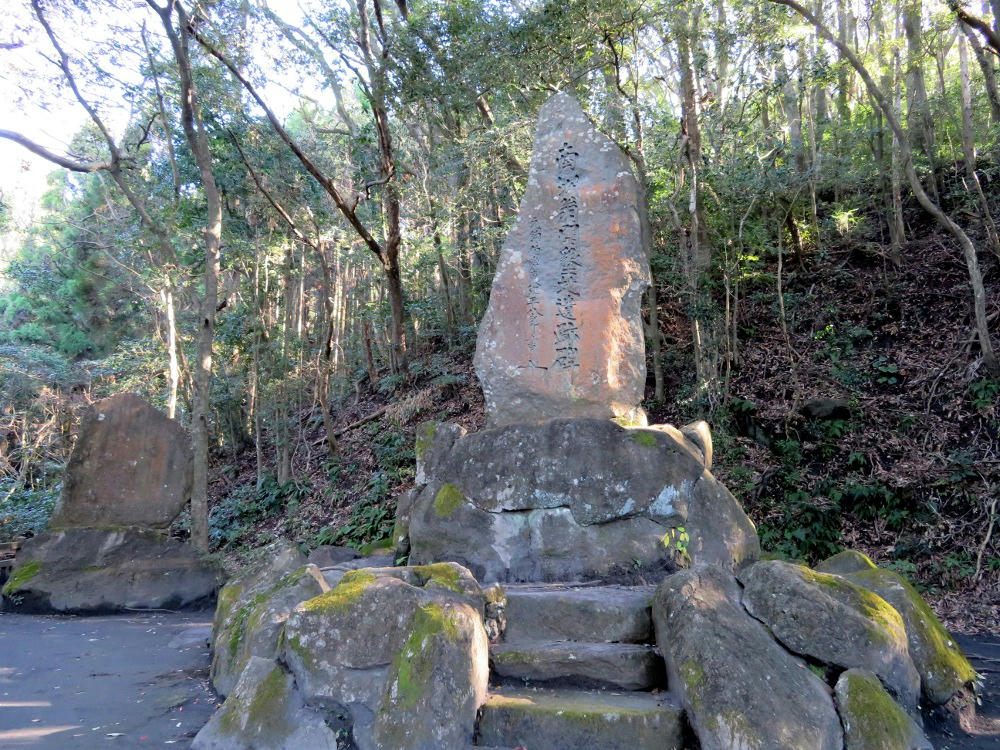
The first was a local monument with a historical marker.
"Site of Saigo's land development company charcoal furnace
"I am getting quite used to tofu dregs and potato rice"
--- From a letter to Oyama, telling how Saigo started his Land Development Company ---
Two years after his plan to send a mission to Korea had been defeated and he returned to Kagoshima, Saigo established the Yoshino Land Development Company at this location in 1875. He bought former clan pasture land from Governor Oyama and developed it with 150 of his military students, coming in everyday from Takemura.
They cultivated the 39 hectare site during the day and studied at night.
However, Saigo's dreams of a peaceful farming life came to nought. His students revolutionary zeal led to the Seinan Civil War and the suicide of their leader."
I don't know where Takemura is, but I'm really hoping it wasn't back in the middle of Kagoshima city, because that would represent something like a 6 mile trek each way every day for something like 2 years.
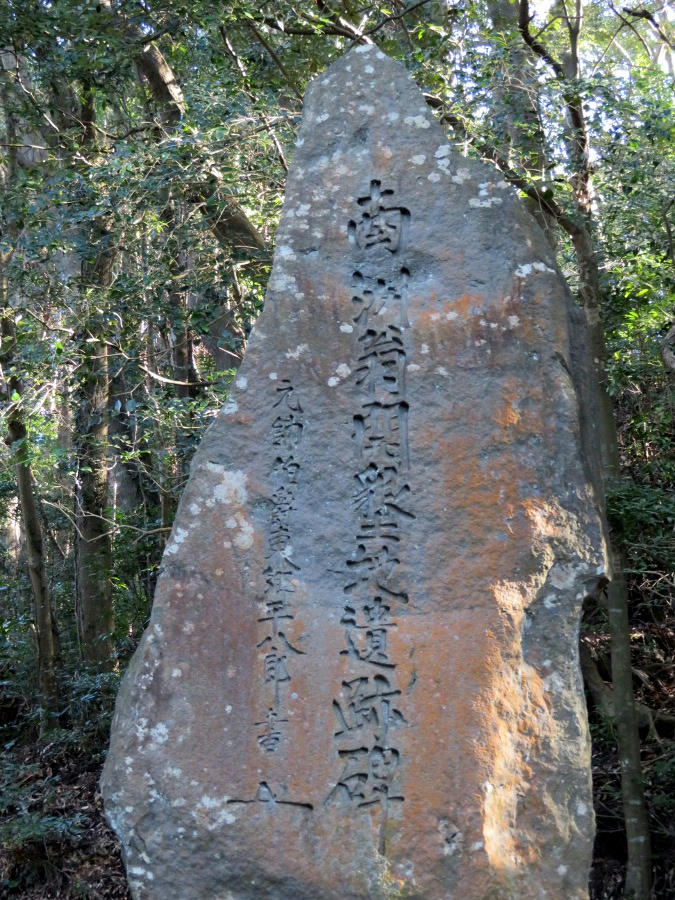
(Close up of the monument, if you want to read it.)
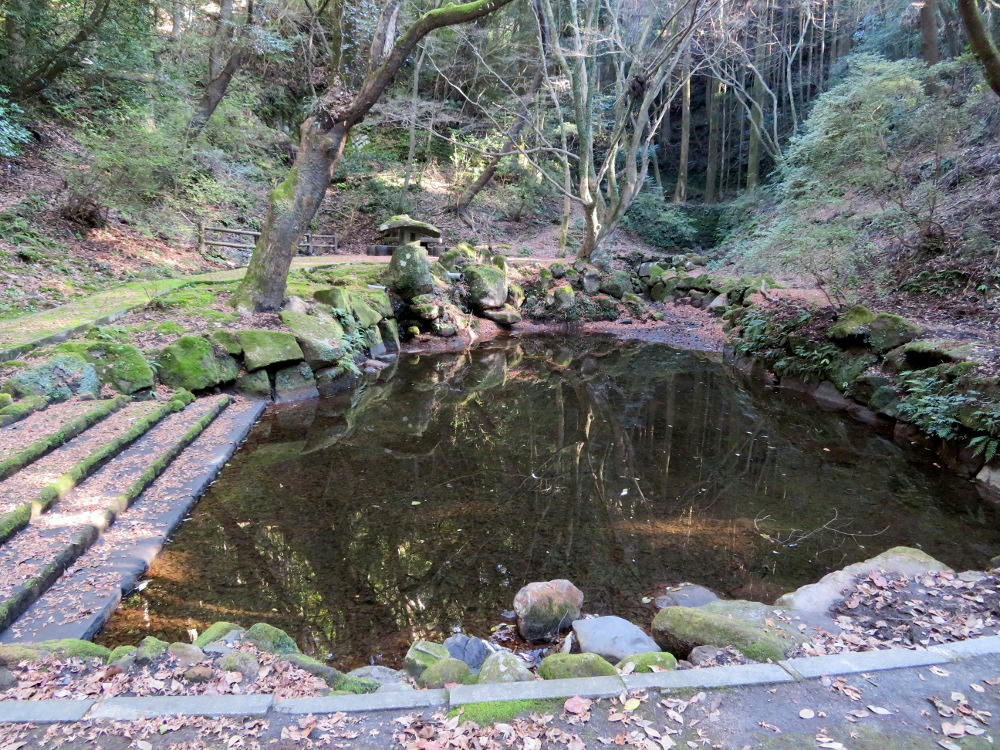
About 20 feet away is a small landscaped pond.
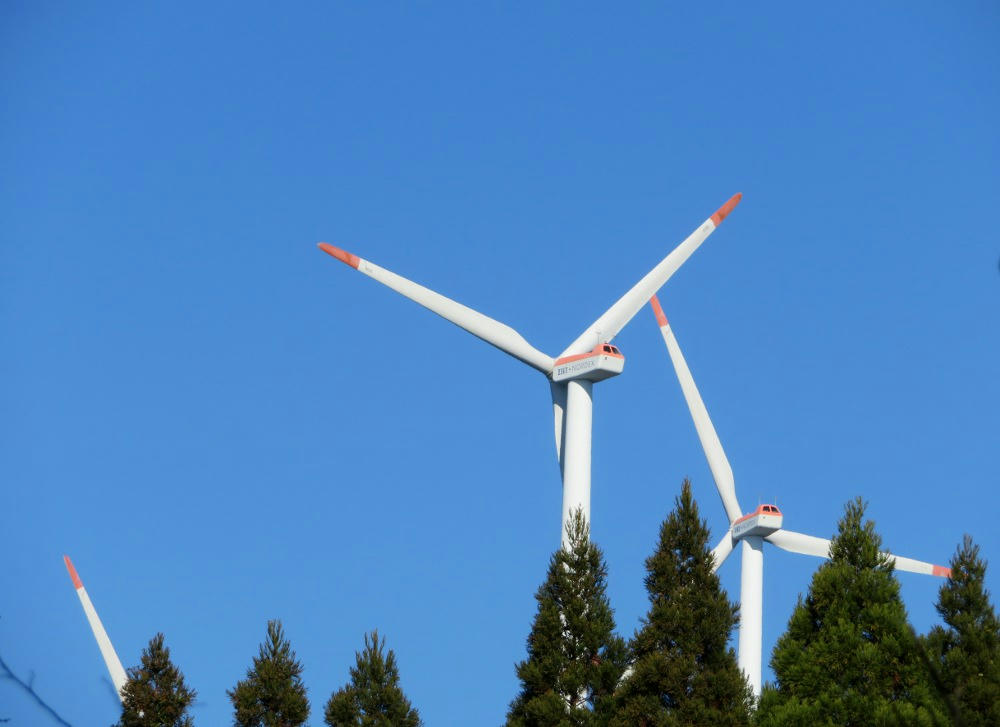
I'm now pretty far up into the tallest hills in the area, and the wind generators are almost close enough to touch. Actually, they're on the next hill over, maybe half a mile away. But, from my apartment I can just barely make them out in the distance, so I'm using this as proof that I walked a lot to get here.
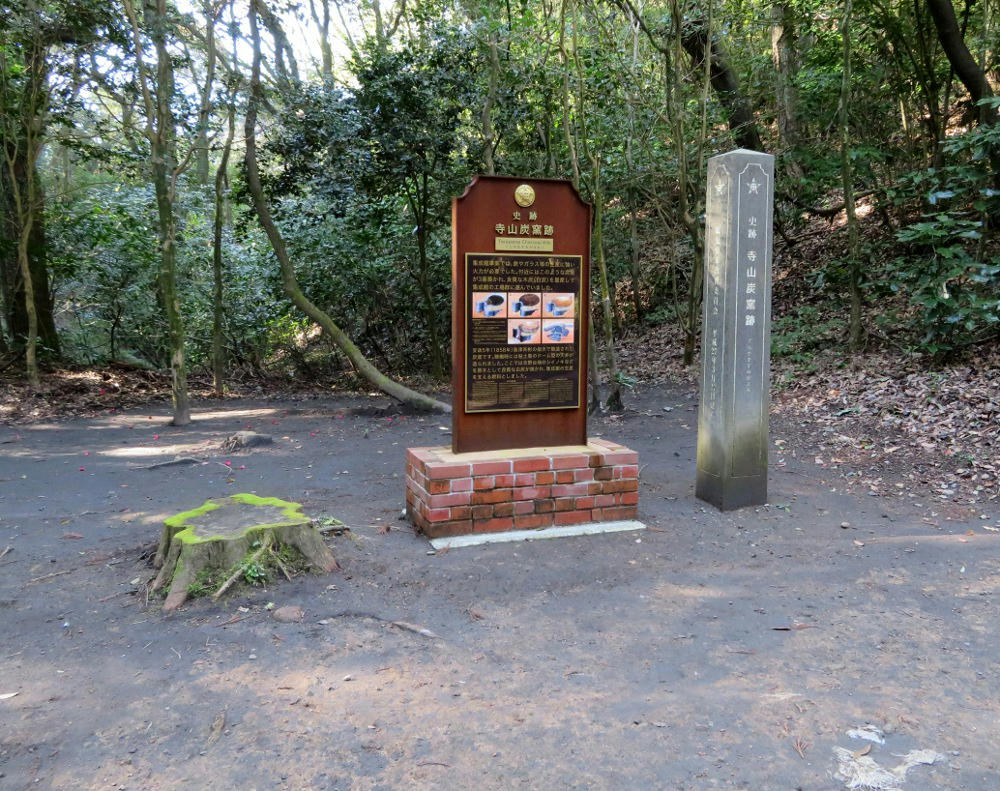
The site of the old kilns. This is in the middle of the woods, and there's nothing else here. But, it's still very well maintained. I guess a groundskeeper comes out here occasionally to sweep up the leaves.
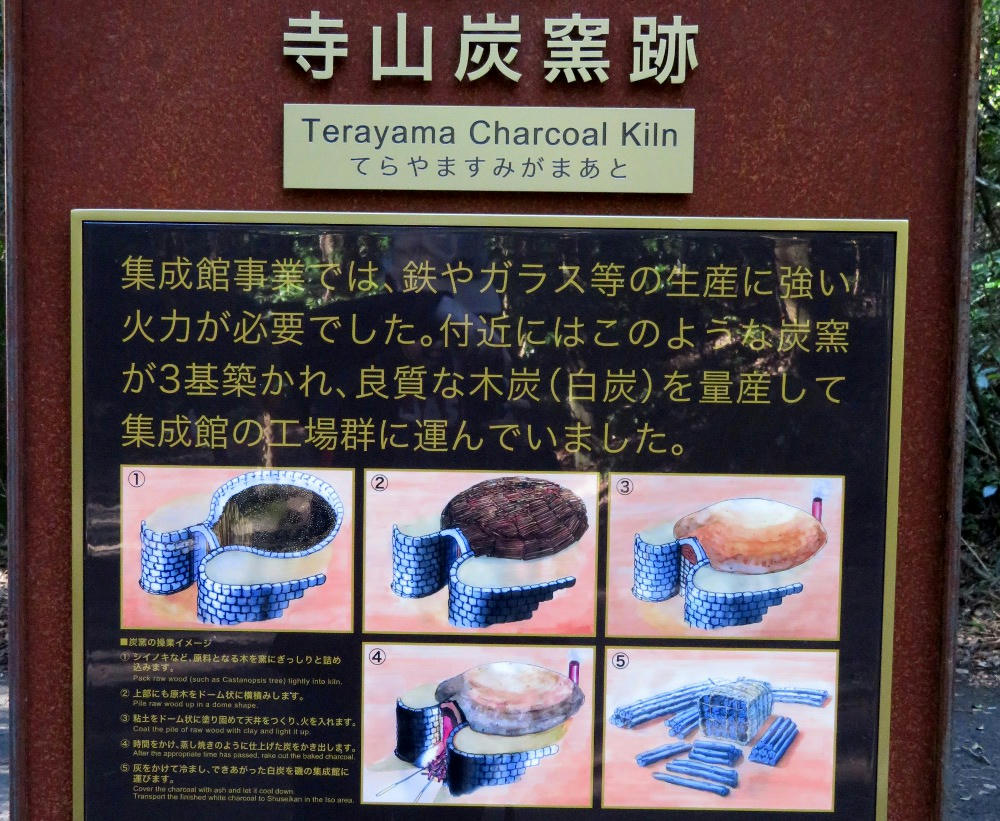
"How to make charcoal:
1) Pack raw wood (such as Castanopsis tree) tightly into kiln.
2) Pile raw wood up in a dome shape.
3) Coat the pile of raw wood with clay and light it up.
4) After the appropriate time has passed, rake out the baked charcoal.
5) Cover the charcoal with ash and let it cool down. Transport the finished white charcoal to Shuseikan in the Iso area."
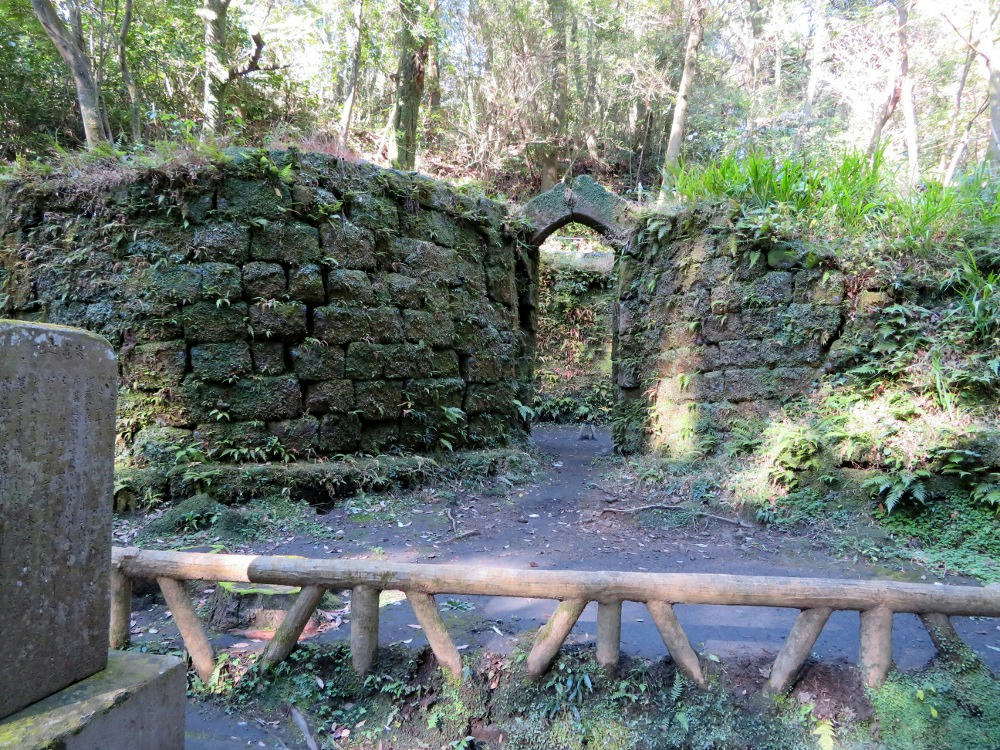
(One of the three old kilns. Check out the historical marker above to see how it was used.)
"Terayama Charcoal Kiln
The Shuseikan project required intense heat in order to produce iron, glassware and other products. Three charcoal kilns were built nearby to produce high-quality charcoal (white charcoal) in large quantities, which was then transported to Shuseikan factories. In 1858 Shimadzu Nariakira built the charcoal kilns. They had a clay dome during the charcoal production process. The high-quality white charcoal made from the castanopsis trees of Yoshino Plateau supported the production activities at Shuseikan factories."
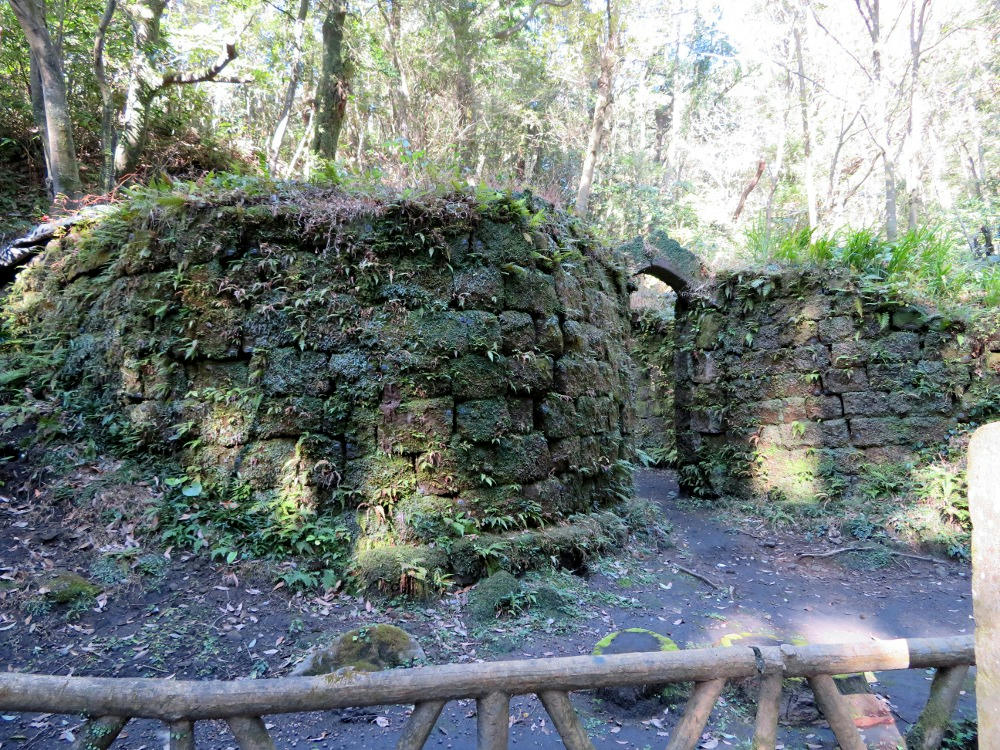
Nariakira Shimadzu was the feudal lord that controlled the land in this area (originally called Satsuma), and was one of the key figures in the war against England, leading up to the Meiji rebellion against the shogun. After losing to the British navy's bigger cannons, Nariakira sent delegates to Europe, England and the U.S. to study western science and technology. When they came back, he had a metalworks constructed on his land at Senganen about 3-4 miles south of the kiln site here, with the intent of building bigger cannons, and his own fleet of ships. Senganen is also the site of the kiriko works, which produces very elegant cut glass cups, vases and plates, initially as a way of establishing Satsuma as a world-class commercial hub. Senganen still makes kiriko, which is very expensive - a small cup starts at $150. The bigger pieces go for $2,000.
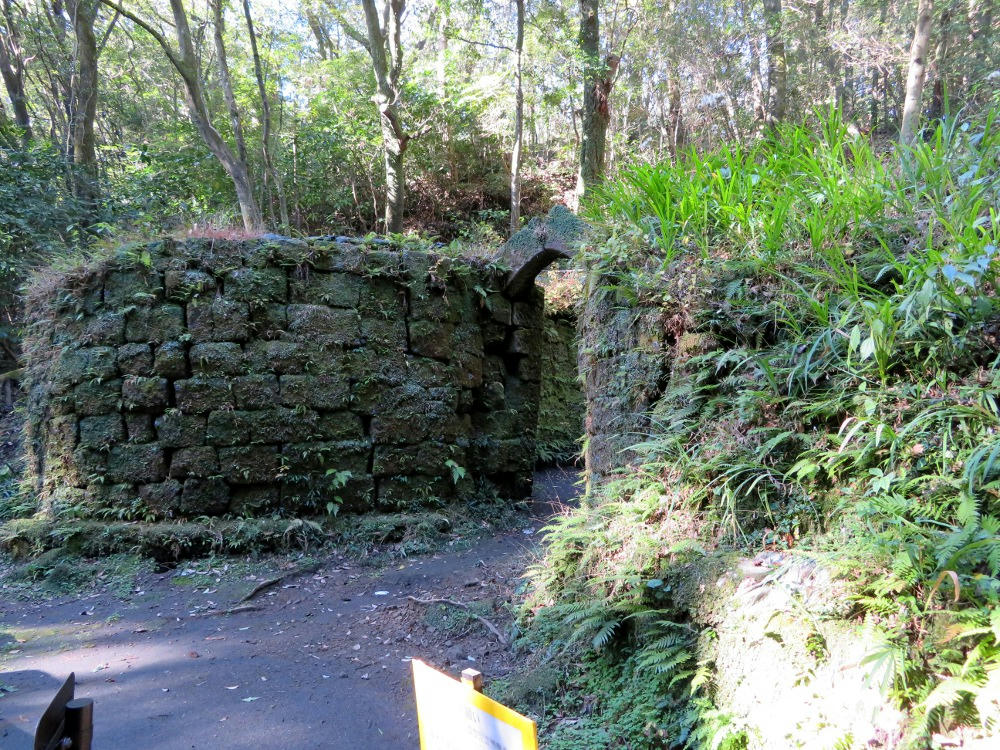
I returned to the entrance of the kiln park, and studied the area map. There was a short stretch to the north that connected to another road. It looked doable, so I hiked to that, and encountered a vending machine at the entrance to a construction company. That led to the false hope that I might find a ramen shop or something along the road around the next curve. A few blocks farther, I passed an abandoned love hotel, a pre-school, and some houses, then more trees.
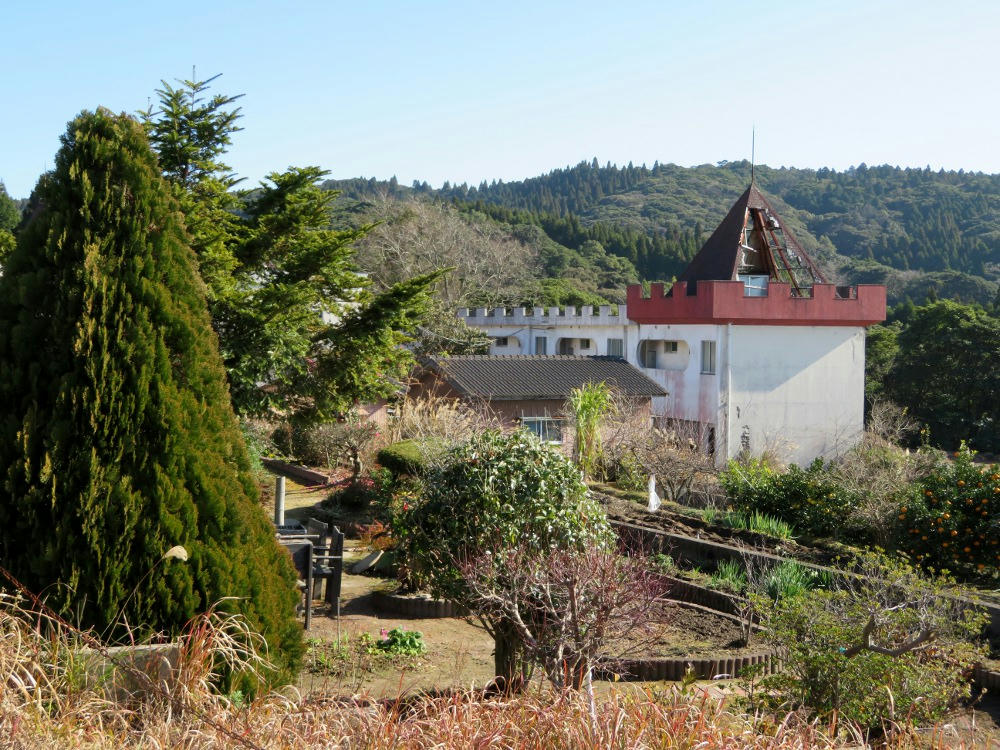
Apparently, someone bought the land and put up a house next to the love hotel, and made themselves a garden there.
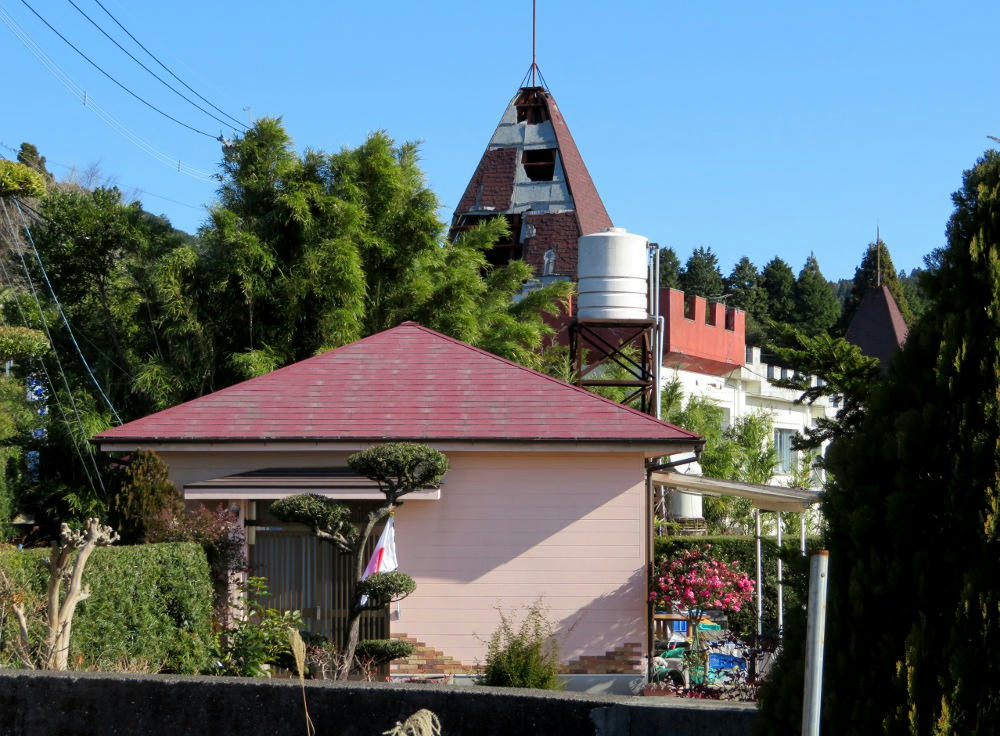
And they plan to just let the love hotel decay under its own weight.
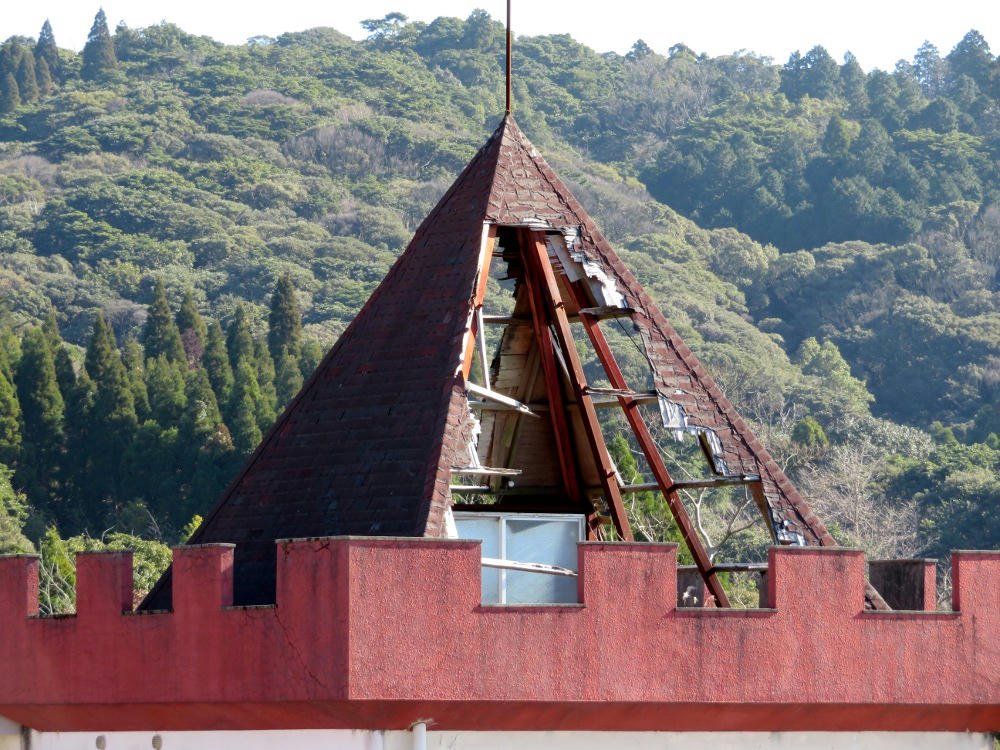
Ok, so now it's 11 AM, and I've been out walking for 4 hours. I have another half of a sandwich, and turn around to go back home. I've got a pretty good mental picture of the places where I'd made turns at each of the intersections, so I'm confident I'm not going to get lost. However, after half a mile, I notice another street running parallel to the one I'm on, a block away and a bit closer to the coastal cliff line. I figure that I won't be going too far out of my way, so I finish the last of my sandwiches and take the new road, which runs right through the Yoshino golf course (they have a cross-over bridge for the golf carts to drive from one half of the course to the other over the main street, and warning signs along the road telling drivers to beware errant golf balls. After I got past the golf course, I reached Yoshino park. According to the map at the street entrance, it's a big park, but it had a ticket gate a ways back from the street, and I assumed they charge money to get inside. I'm tired now and unable to appreciate being in a park, so I keep walking. I finally got to a street I recognized, but a quarter-mile later I made a wrong turn at another intersection, which took me a quarter of a mile farther up the road from Yoshino city. The good thing about this is that I had been wondering what was up that road from Yoshino. The bad thing is that the answer is "clothing shops, cram schools and real estate agencies." No ramen shops, restaurants or convenience stores.
I turned left to go south on this road, and after 15 minutes it brought me to the 215 turn off. I'm now on terra cognita, and close to a Lawson's konbini. I go inside to buy another sandwich (ham and cheese this time) and a bottle of blueberry yogurt drink. I finish off the yogurt drink in the parking lot, and aim for Kagoshima city. The trip is all downhill, which meant that I could walk it faster. Unfortunately, it also put a lot of stress on my knees and ankles because it's like I'm trying to go down a REALLY long flight of stairs.
The return trip was mostly uneventful. I got to Reimeikan, and the International Volunteer Center at 1:30 PM. I was hoping to go into the Volunteer Center, to sit down and rest a bit, and maybe get a bento box for lunch from the kiosk in there. But, the building was still locked up for the holidays, so I kept going. I reached the apartment almost exactly at 2 PM, just short of 7 hours from when I'd started. The weather had been good, a bit cool, but clear skies. When I checked the mirror in the bathroom, I discovered that my face had gotten a really nice sunburn on my nose and cheeks. Sigh. My legs and feet were killing me, and I had very little energy left, even though I'd eaten all of the second sandwich, and drank just under 1.5 liters of water for the day.
As stated above, my intent had been to determine my limits. I don't want to bother working out the distances from the google map. I know that from the Myoenji organized walk, I can do 20 km (12 miles) in 3.5 hours, but that's when I'm really trying to push myself. If I figure worst-case that I was walking 2 miles an hour, including my sight-seeing at the different shrines, my bottom estimate would be 14 miles round-trip. A more optimistic speed of 3 miles an hour would give me a top limit of 21 miles. I could split the difference and call it 17.5 miles in 7 hours.
I don't think I'm able to claim that I can do this two days in a row, though.




No comments:
Post a Comment